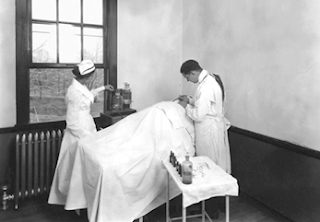"I found this place to be the most interesting
places I have ever read about."
During the 1800s and early 1900s, America was ravaged by a deadly disease known by many as the “white death” tuberculosis. This terrifying and very contagious plague, for which no cure existed, claimed entire families and sometimes entire towns. In 1900, Louisville, Kentucky had one of the highest tuberculosis death rates in America. Built on low, swampland, the area was the perfect breeding ground for disease and in 1910, a hospital was constructed on a windswept hill in southern Jefferson County that had been designed to combat the horrific disease. The hospital quickly became overcrowded though and with donations of money and land, a new hospital was started in 1924.
In many cases, the treatments for the disease were as bad as the disease itself. Some of the experiments that were conducted in search of a cure seem barbaric by today’s standards but others are now common practice. Patient’s lungs were exposed to ultraviolet light to try and stop the spread of bacteria. This was done in “sun rooms”, using artificial light in place of sunlight, or on the roof or open porches of the hospital. Since fresh air was thought to also be a possible cure, patients were often placed in front of huge windows or on the open porches, no matter what the season. Old photographs show patients lounging in chairs, taking in the fresh air, while literally covered with snow.
 |
Patients take in the sunlight on the open porches outside of the rooms. |
Other treatments were less pleasant --- and much bloodier. Balloons would be surgically implanted in the lungs and then filled with air to expand them. Needless to say, this often had disastrous results, as did operations where muscles and ribs were removed from a patient’s chest to allow the lungs to expand further and let in more oxygen. This blood-soaked procedure was seen as a “last resort” and few of the patients survived it.
 | ||||
| A staged display of the Pneumothorax procedure -- without all of the blood |
By the late 1930s, tuberculosis had begun to decline around the world and by 1943, new medicines had largely eradicated in the United States. In 1961, Waverly Hills was closed down but was re-opened a year later as Woodhaven Geriatrics Sanitarium. There have been many rumors and stories told about patient mistreatment and unusual experiments during the years that the building was used an old age home. Some of them have been proven to be false but others have unfortunately turned out to be true. Electroshock therapy, which was considered to be highly effective in those days, was widely used for a variety of ailments. Budget cuts in the 1960s and 1970s led to both horrible conditions and patient mistreatments and in 1982, the state closed the facility for good.
ROOM 502
Perhaps the most infamous area of all in the hospital. is room 502. The story goes that In 1928, the head nurse was found dead in the room. She had hanged herself from the light fixture. No one knows why the 29-year old woman would take her own life, but it's believed that she was unmarried and pregnant. It is unknown how long her body hung before she was finally discovered. The county coroner’s office attributed her death to suicide.
In 1932, another nurse who worked in room 502, supposedly committed suicide when she jumped from the balcony of the roof. No one knows why.
Folks have seen the full body apparition of a female nurse in white on this floor.
People have also reported that this room gives them an "unsettling" feeling of great despair. Some have heard a voice say, "Get out!"
BODY CHUTE
What is now called the “body chute” is actually a 500 foot long tunnel that leads from the hospital to the railroad tracks at the bottom of the hill. When someone died they were sent down the tunnel via gurneys to an awaiting hearse. This was done so that patients wouldn't see the hearses or the bodies--in order to keep morale high. Concrete steps line one side of the tunnel while the other side consists of a motorized rail and cable system. Voices are often heard along the long eerie passage.




No comments:
Post a Comment